- Home
- Fishing Rigs
- Ballyhoo Rigging
The Best Ballyhoo Rigging Method for Offshore Trolling
Going about ballyhoo rigging the right way is vital, or your hook-up rate will be pretty dismal. Their beak, and elongated shape does means that a special approach is required.
Most important is the position of the hook. If it's too far forward you'll be retrieving half a ballyhoo more often than not. This rig will put the hook well towards the tail of the ballyhoo, and well into the mouth of the predator.
First though, as with all baitfish, the ballyhoo must be prepared before the rigging procedure can begin, otherwise it won't wriggle convincing - and worse, it will probably spin.
Here's how to make sure it will behave as it should ...
Baitfish Preparation
To resemble their living brethren, dead bait fish must 'swim' convincingly - they should wriggle, but not spin. And for a lifelike wriggle, the bait fish must be flexible. And here's how to make it so ...
- First, empty the bait fish's gut cavity by squeezing firmly with thumb and forefinger along the belly towards its anal vent;
- Then, pinch the bait progressively along its backbone to detach the flesh from the bone, but take care not to break the skin. Flex it back and forth a few times to complete the loosening up process;
- Next, remove the eyes. Otherwise, water pressure may cause them to bulge unequally, inducing rotation. A small wooden dowel is ideal for pushing them out of their sockets;
- Finally, trim off the pectoral and pelvic fins. Any unequal projection here and a propeller effect will be set up.
This is an essential part of the ballyhoo rigging process. Now your baitfish is limp and flexible, and ready for rigging.
Ballyhoo Rigging
Having loosened it up, the ballyhoo rigging process can begin. But just one more thing. Break off its beak leaving a stub of about an inch (25mm) - you'll see why shortly. If this is done by snapping carefully downwards, a useful groove will be left on the underside of the stub.
The ballyhoo rigging technique described here uses a head spike (or head-pin) which is a vertical spike of single strand wire, incorporated into the extended haywire twist used to attach the hook in a single-strand wire leader. So, let's get started...
Stage 1
First, attach a suitably sized hook with a haywire twist.
The length of the haywire twist should be such that distance from the
final twist to the bend of the hook is just over half the length of the
bait.
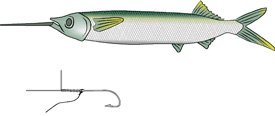
Don't snap off the wire in the normal way, but leave a spike sticking up in the same vertical plane as the hook.
Note ~ In the illustration the haywire twist is too short. My fault, I'll change it as soon as I can.
Stage 2
Then, insert the hook point under the gill cover and work it through into the body cavity.
Bring the hook point out through the belly, leaving the spike under the bait's head.

After checking that the hook and the spike are in the same plane, push the spike up and out through the top of the head level with the eyes.
Stage 3
Next, check that the hook moves freely where it exits the fish's belly.
If it doesn't, carefully cut a longitudinal slot at the point of entry with a sharp knife so that it can.

Note ~ As the haywire twist is too short in the illustration, the hook exits in the wrong place. Done correctly the hook would exert just over halfway down the fish.
Stage 4
Now lock the spike to the fish's head with a small elastic band
Hook one end over the spike, wrap it once or twice around the head and hook the other end back over the spike.
Alternatively, you can use monel or light copper wire instead of the elastic band.

Artwork by Andrew Simpson
Poke the wire through the eye sockets, wrap the ends around the head behind the spike and finish off with a few turns around the bill stub, which will locate the leader in the groove we mentioned earlier.
Stage 5
Finally, eyeball the ballyhoo head-on.
The hook and the head-spike must all be on the centreline in the vertical plane, or the bait will spin.
Hold the leader and let the bait hang down. Double-check that the hook's not pulling on the belly.
Properly rigged, the bait will be towed by the head spike and won't spin. If it does, tweak the rig until it doesn't or start again.
Rigged in this way, your ballyhoo will skip along, or just under the surface. If you want to troll deeper, slide an egg sinker down the line to the head of the bait, and secure it in place with soft wire.
The final embellishment is to slide a lure - such as sea witch, trolling feather, straight runner, clone, jethead or simply an octopus skirt - down the leader so that it locates against the egg sinker if you're using one, or the nose of the bait if you're not.
But if your target fish is dorado or tuna, you may want to take your chances with wahoo and their toothy chums, and go for a less visible mono leader.
80lb breaking strain is as light as you should go, using one crimp to secure the hook and another to attach the separately formed L-shaped spike in the appropriate position. A chin weight can be incorporated into the crimped hook connection if required.
The Bait Rigging Kit You'll Need
If you haven't already got it, you're going to need a Crimping Tool and a selection of suitable sleeves. This rigging kit comes well recommended...
Clearly, the rig must be properly made up, so here are some tips on using your bait rigging kit.
Follow these carefully and you'll soon be an expert!
Recent Articles
-
Sea Fishing Rods and Reels Must Be Compatible for a Balanced Outfit
Mar 08, 21 08:30 AM
A quality reel fitted to a quality rod doesn't necessarily make it a quality outfit. Your fishing rods and reels have to be properly matched if you're to get the best out of them, and here’s how -
Essential Lure Fishing Tips That All Saltwater Anglers Should Know
Mar 08, 21 04:51 AM
Which single lure fishing tip applies to trolling, jigging, baitcasting, spinning, fly fishing and any other branch of lure fishing? Well, it is the one at the top of this list -
Vital Jig Fishing Tips That You Really Cannot Afford To Miss!
Mar 07, 21 10:20 AM
Essential jig fishing tips to help you select the right lure for successful jig fishing, together with the techniques required to get the most out of your jig fishing outfit
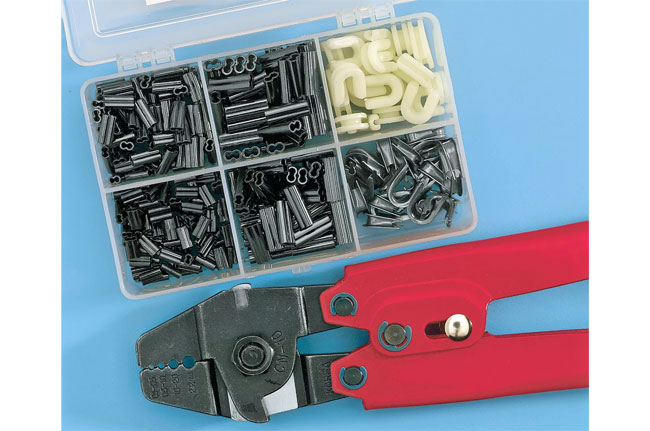



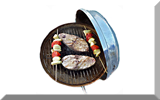
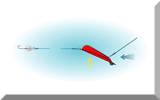
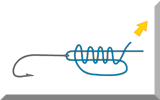
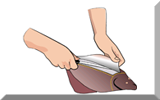
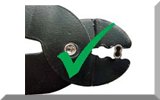
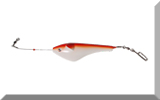
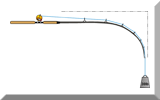
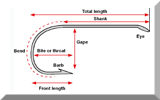
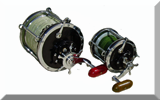
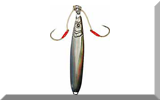
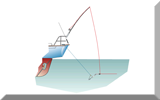
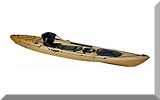
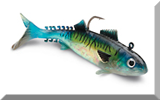
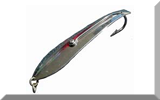
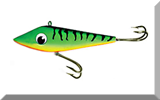
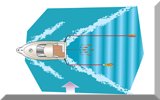
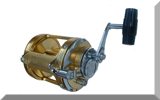
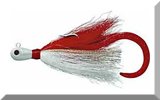
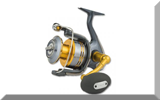
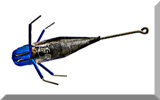
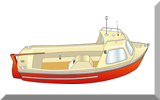
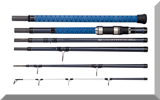
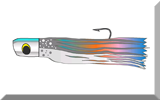
New! Comments
Have your say about what you've just read! Leave me a comment in the box below.